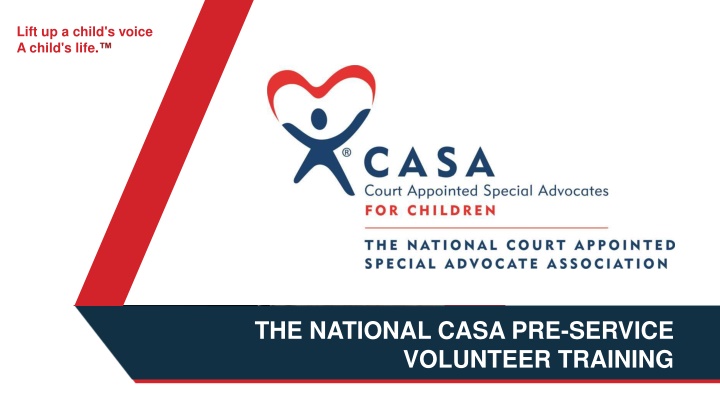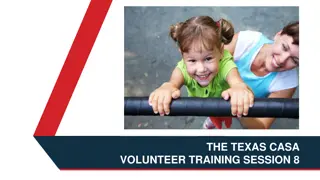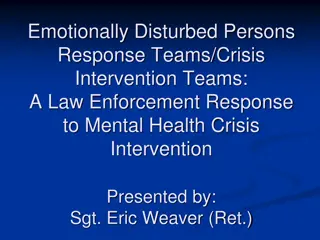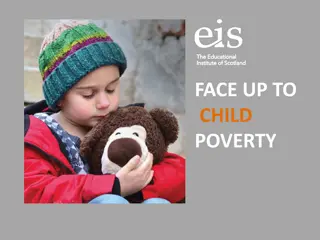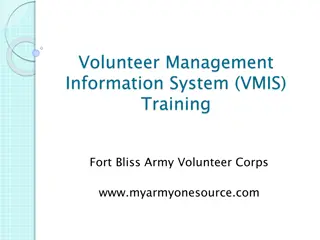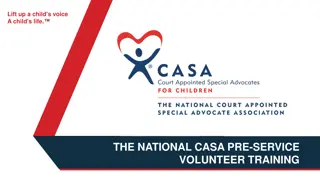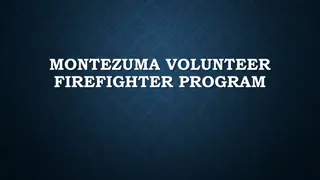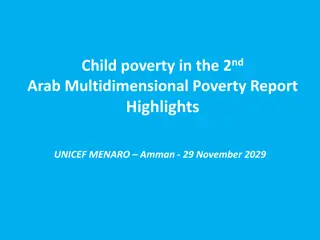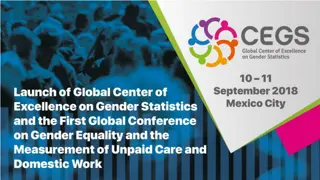National CASA Pre-Service Volunteer Training: Mental Health, Poverty & Communication
This training program focuses on addressing mental health, poverty, and effective communication skills within the context of advocating for children in need. Volunteers learn about understanding societal issues impacting families, requesting confidential information, and collaborating with professionals to ensure the well-being of children. Through a series of pre-work activities and informative articles, volunteers are equipped to navigate the complexities of child advocacy and provide support where needed.
Download Presentation

Please find below an Image/Link to download the presentation.
The content on the website is provided AS IS for your information and personal use only. It may not be sold, licensed, or shared on other websites without obtaining consent from the author.If you encounter any issues during the download, it is possible that the publisher has removed the file from their server.
You are allowed to download the files provided on this website for personal or commercial use, subject to the condition that they are used lawfully. All files are the property of their respective owners.
The content on the website is provided AS IS for your information and personal use only. It may not be sold, licensed, or shared on other websites without obtaining consent from the author.
E N D
Presentation Transcript
Lift up a child's voice A child's life. THE NATIONAL CASA PRE-SERVICE VOLUNTEER TRAINING
Chapter 4: Mental Health, Poverty & Professional Communication Pre-Work Recap, Chapter Overview & Competencies Mental Health Poverty Skill Building: Professional Communication Chapter Wrap-Up: Review & Evaluation Working a Case Chapter 5: Pre-Work 2
Chapter 4: Pre-Work Recap Read the article on mental illness in families. Read the articles about medicating children in foster care and a multimodal approach to managing mental health disorders in children and be prepared to discuss the points brought up by the author. Also, be prepared to discuss the questions that advocates should ask. Read the article on Why Are Poor Children More Likely to Be in the System? 3
Chapter 4: Pre-WorkRecap (Cont d.) Research answers to these questions: What is the minimum wage in your state? What are the current poverty guidelines for a family of four in your state? What percent of people of color in your state fall within the poverty guidelines? What percent of the white population in your state fall within the poverty guidelines? Complete the activity on examining poverty vs. neglect scenarios. Read the article on how to obtain confidential case-related records. 4
Chapter 4: Pre-WorkRecap (Cont d.) Read the article on Confidentiality and the CASA/GAL Volunteer. Read the article on the Necessity of Timely, Effective Communication. Read the article on the Fine Art of Team Work (Child Protection Is Not an Individual Sport). Read the Initial Case Notes for the Greene Case. Visit an agency by taking public transportation. (Optional: Facilitator will decide whether to assign.) 5
Chapter 4: Overview This chapter introduces two common societal issues that may impact the children and families you are working with: mental illness and poverty. This chapter also offers additional information about communication skills, including requesting confidential information and working with professionals on a case. 6
Chapter 4: Chapter Overview and Competencies Competency Category CASA/GAL Role Foundation of Knowledge Knowledge, Skills, Attributes, Behavior Development in Chapter 4 Understands how to obtain relevant confidential information Understands how mental illness affects families Understands strategies to advocate for children and adolescents with mental health disorders Understands how poverty can impact families and children Understands the confidentiality requirements of being a CASA/GAL volunteer Sound Judgment 7
Chapter 4: Mental Health, Poverty & Professional Communication Pre-Work Recap, Chapter Overview & Competencies Mental Health Poverty Skill Building: Professional Communication Chapter Wrap-Up: Review & Evaluation Working a Case Chapter 5: Pre-Work 8
Chapter 4: Mental Illness in Families A mental illness is a condition that impacts a person s thinking, feeling or mood and may affect his or her ability to relate to others and function on a daily basis. Each person will have different experiences, even people with the same diagnosis. The National Alliance on Mental Illness P2 9
Chapter 4: Causes of Mental Illness Usually has origins in multiple causes, such as genetics, biology, environment & life stressors It is not caused by personal weakness or a character defect Mental illness affects the whole person P2 10
Chapter 4: Impact on Children Children of a parent with mental illness may experience: Inappropriate levels of responsibility Self-blame for their parents problems Anger, anxiety or guilt Embarrassment, shame or isolation Increased risk of school-related problems, drug use & poor social relationships Risk of mood disorders, alcoholism & personality disorders P2 11
Chapter 4: Mental Illness in Families As a CASA/GAL volunteer: It is not your task to diagnose mental illness Focus less on a parent s diagnosis and more on his/her ability to provide a safe home for the child Be aware of indicators that may point to the need for professional assessment P5 12
Chapter 4: Mental Illness in Families Some possible indicators of mental health issues: Social withdrawal Thought disorders Expression of feeling disproportionate to the circumstances Depression Behavior changes P5 13
Chapter 4: Understanding Mental Illness 4A Understanding Mental Illness 1B 14
Chapter 4: Mental Health for Children in Care Without adequate understanding of mental health, medications can harm children When emotional trauma is the cause, both therapy and medication are required Medications can be part of a successful intervention and treatment plan to: Address depression or suicidal thinking Contain self-abusive behaviors Reduce risk-taking behaviors P7 15
Chapter 4: Multimodal Approach to Mental Health Medication treatment or psychopharmacology Behavioral therapy Cognitive behavioral therapy Play therapy Child-parent psychotherapy Dialectical behavioral therapy (DBT) P8 16
Chapter 4: Questions Advocates Should Ask What is this medication needed for? Were you able to obtain an accurate medical, behavioral and psychological history from parents and past providers? What else has been tried? What other modes of treatment or intervention will also be provided? Who will monitor the ongoing use of this medication? How often will this child be seen? What are the possible side effects of this medication and how will they be handled? What evidence supports the use of this medication with children? P9 17
Chapter 4: Questions Advocates Should Ask Will this child be able to comply with the prescribed medication? Does the child agree with taking this medication? Who has given permission to begin this child on medication? What other medications is this child on? Can this medication be safely combined with the current medication? How will this medication help improve this child s functioning? What are the risks versus benefits of using this medication? What are the risks versus benefits of not using the medication? Is a second opinion warranted in this case? P9 18
Chapter 4: Mental Health Treatment for Children in Care 4B Mental Health Treatment for Children in Care 1B 19
Chapter 4: Mental Health, Poverty & Professional Communication Pre-Work Recap, Chapter Overview & Competencies Mental Health Poverty Chapter Wrap-Up: Review & Evaluation Skill Building: Professional Communication Working a Case Chapter 5: Pre-Work 20
Chapter 4: Poverty The majority of children you will encounter as a CASA/GAL volunteer will be living at or below the poverty level. Developing a better understanding of the realities of poverty will assist you in being a better advocate. 21
Chapter 4: Poverty Pre-Work Questions 4C What is the minimum wage in your state? What are the current poverty guidelines for a family of four in your state? What percent of people of color in your state fall within the poverty guidelines? What percent of the white population in your state fall within the poverty guidelines? P10 22
Chapter 4: Visiting An Agency (optional) 4C Describe the preparations you had to make. How does riding public transportation put you in touch with the experiences of poor families who have no other means of getting around? What agencies did you visit? What services do they provide? How does this experience help you understand the stigma associated with being poor? 23
Chapter 4: Why Are Poor Children More Likely to Be in the System? 4D Poverty causes great stress in families Poor families turn to system for reasons other than abuse Poverty itself is a major risk factor of abuse Poor families of color are more likely to be reported for abuse and neglect Children living in poverty are more likely to have difficulty in school, become teen parents, and as adults, earn less and be unemployed more P12 24
Chapter 4: Risk Factors of Poverty 4D Poor children face a greater risk of impaired brain development due to exposure to a number of other risk factors: Inadequate nutrition Parental substance abuse Maternal depression Exposure to environmental toxins Low-quality daycare P13 25
Chapter 4: Why are Poor Children More Likely to be in the System? 4D Why are Poor Children More Likely to Be in the System? 1B 26
Chapter 4: Poverty vs. Neglect 4E Are the following safety issues? A family does not have a refrigerator A family lives in a rental unit with holes in the floor A family lives in a car Is this a child safety issue? A family does not have a regular pediatrician A family does not have electricity A family does not have money to buy the mother s antidepressant medication A family does not have a crib for their infant A family has one parent who uses drugs P14 27
Chapter 4: Mental Health, Poverty & Professional Communication Pre-Work Recap, Chapter Overview & Competencies Mental Health Poverty Chapter Wrap-Up: Review & Evaluation Working a Case Skill Building: Professional Communication Chapter 5: Pre-Work 28
Chapter 4: Obtaining Confidential Case Records 4F As a court-appointed advocate, you have access to child s records To obtain parents records, submit a release of information (signed by the parent) to the agency To obtain information from child protective services agencies and schools, you can use a discovery legal process Local CASA/GAL program provides direction on how best to access child protective services documents, school records and other information 29
Chapter 4: Obtaining Confidential Case Records 4F To obtain records from child welfare agencies, hospitals and schools, call ahead and place a request If you are denied access to records, contact your CASA/GAL volunteer supervisor Your local program will provide advise on how to access medical records, post hospital names and contact information on the program s website or provide a handout Due to law, some caregiver records that can be inaccessible are drug information, doctor and hospital records and mental health records P16 30
Chapter 4: Obtaining Confidential Records 4F Obtaining Confidential Records 1B 31
Chapter 4: Confidentiality Flowchart 4G Is it in the child s best interest to share this information? Do not share the information. Contact CASA/GAL program staff NO NO YES Resist sharing the information. Is the person legally entitled to it? YES Is it my information to share? Contact CASA/GAL program staff. NO Direct the person asking to the original source. YES Is the person legally entitled to the information? NO Tell the person that he or she will need to obtain a court order YES Share the information. 32
Chapter 4: Timely, Effective Communication 4H Juvenile court system functions on strict timelines to place a child in a safe, permanent home Successful completion of a case plan is at times difficult for parents, especially with drug and mental health issues As a CASA/GAL volunteer, you have to speak with various people on a case, with different mandates and rules As a CASA/GAL volunteer, you should be a facilitator of communication between involved parties and workers Open, respectful communication among all involved is critical to serving the child s best interests P20 33
Chapter 4: The Fine Art of Teamwork 4H Common Sense Ideals Open and Successful Decision Making What to Do If Someone Isn t Being a Team Player Team Building Practices 34 P21
Chapter 4: Effective Communication with Professionals on a Case 4H Effective Communication with Professionals on a Case 1B 35
Chapter 4: Mental Health, Poverty & Professional Communication Pre-Work Recap, Chapter Overview & Competencies Mental Health Poverty Chapter Wrap-Up: Review & Evaluation Working a Case Skill Building: Professional Communication Chapter 5: Pre-Work 36
Chapter 4: The Greene Case 4I The Greene Case 1B P23 37
Chapter 4: Taking Case Notes 4J Taking Case Notes 1B 38
Chapter 4: Mental Health, Poverty & Professional Communication Pre-Work Recap, Chapter Overview & Competencies Mental Health Poverty Chapter Wrap-Up: Review & Evaluation Skill Building: Professional Communication Working a Case Chapter 5: Pre-Work 39
Chapter 4: Mental Health, Poverty & Professional Communication In this chapter, you learned about: Mental illness effects on families and children Medication risks for children in out-of-home placement Poverty as a risk factor for abuse or neglect Differences between poverty and neglect Best method for obtaining confidential information Importance of professional, effective communication in CASA/GAL volunteer work Clear and detailed interview notes to be used in writing a volunteer court report 40
Chapter 4: Evaluation Please fill out the Chapter 4 volunteer training evaluation and give to the facilitator. 41
Chapter 5: Pre-Work Read the National Institute on Drug Abuse information about commonly abused drugs Read the statistics about substance abuse Read the National CASA Vision Statement and Guiding Principles Read the Cultural Competence Glossary Read information about disproportionality and disproportionality statistics Read the Initial Case Notes for the Lavender Case Read examples of good and bad reports and answer: Which statements are opinion-based? Which statements are fact-based? What s missing from each example? What could be improved in each example? 42
